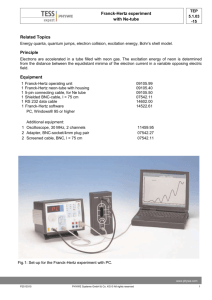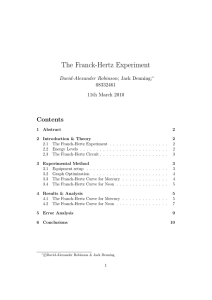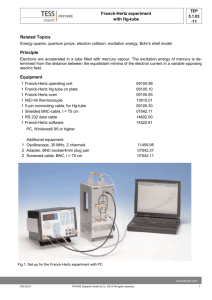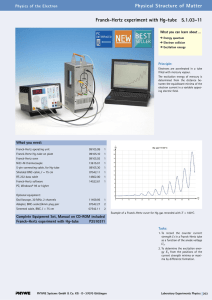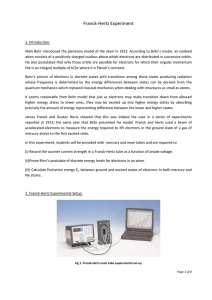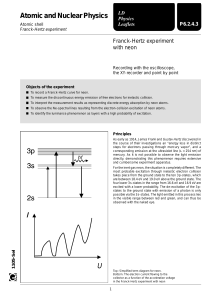Report
advertisement
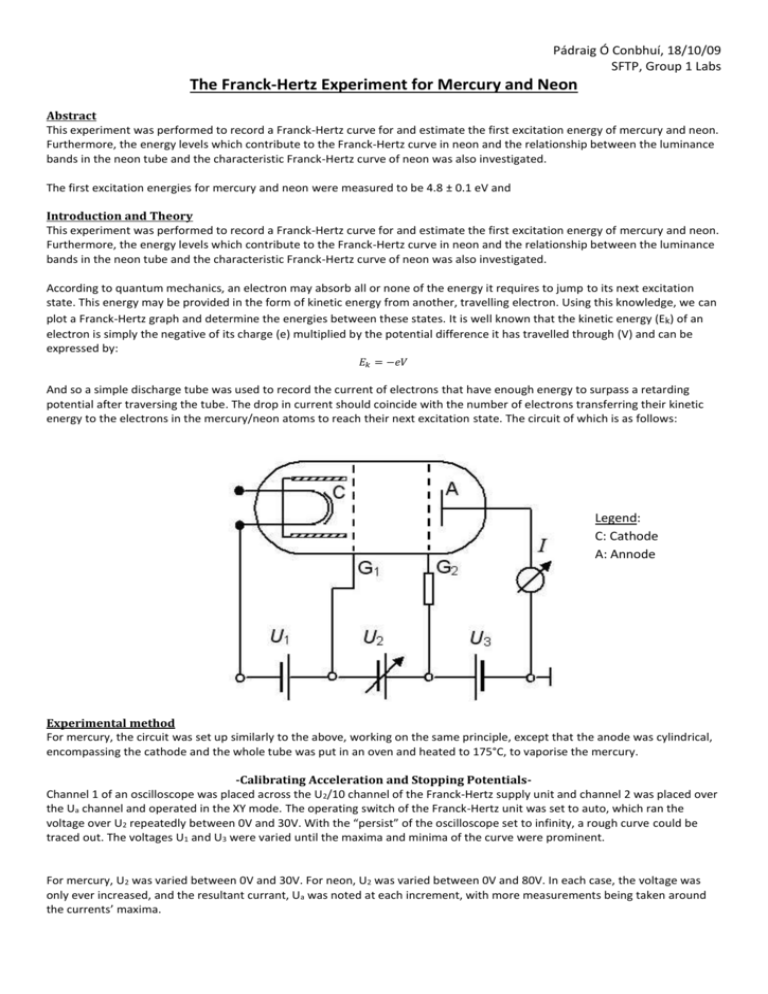
Pádraig Ó Conbhuí, 18/10/09 SFTP, Group 1 Labs The Franck-Hertz Experiment for Mercury and Neon Abstract This experiment was performed to record a Franck-Hertz curve for and estimate the first excitation energy of mercury and neon. Furthermore, the energy levels which contribute to the Franck-Hertz curve in neon and the relationship between the luminance bands in the neon tube and the characteristic Franck-Hertz curve of neon was also investigated. The first excitation energies for mercury and neon were measured to be 4.8 ± 0.1 eV and Introduction and Theory This experiment was performed to record a Franck-Hertz curve for and estimate the first excitation energy of mercury and neon. Furthermore, the energy levels which contribute to the Franck-Hertz curve in neon and the relationship between the luminance bands in the neon tube and the characteristic Franck-Hertz curve of neon was also investigated. According to quantum mechanics, an electron may absorb all or none of the energy it requires to jump to its next excitation state. This energy may be provided in the form of kinetic energy from another, travelling electron. Using this knowledge, we can plot a Franck-Hertz graph and determine the energies between these states. It is well known that the kinetic energy (Ek) of an electron is simply the negative of its charge (e) multiplied by the potential difference it has travelled through (V) and can be expressed by: 𝐸𝑘 = −𝑒𝑉 And so a simple discharge tube was used to record the current of electrons that have enough energy to surpass a retarding potential after traversing the tube. The drop in current should coincide with the number of electrons transferring their kinetic energy to the electrons in the mercury/neon atoms to reach their next excitation state. The circuit of which is as follows: Legend: C: Cathode A: Annode Experimental method For mercury, the circuit was set up similarly to the above, working on the same principle, except that the anode was cylindrical, encompassing the cathode and the whole tube was put in an oven and heated to 175°C, to vaporise the mercury. -Calibrating Acceleration and Stopping PotentialsChannel 1 of an oscilloscope was placed across the U2/10 channel of the Franck-Hertz supply unit and channel 2 was placed over the Ua channel and operated in the XY mode. The operating switch of the Franck-Hertz unit was set to auto, which ran the voltage over U2 repeatedly between 0V and 30V. With the “persist” of the oscilloscope set to infinity, a rough curve could be traced out. The voltages U1 and U3 were varied until the maxima and minima of the curve were prominent. For mercury, U2 was varied between 0V and 30V. For neon, U2 was varied between 0V and 80V. In each case, the voltage was only ever increased, and the resultant currant, Ua was noted at each increment, with more measurements being taken around the currents’ maxima. Results and Analysis -Mercury- ∇U2 was obtained by measuring the mean distance between the peaks of the graph. So ∇𝑈2 = 𝑚𝑎𝑥2 − 𝑚𝑎𝑥1 . Values for ∇𝑈2 were taken for each peak and the average, ̅̅̅̅̅ ∇𝑈2 , was found, and from there, E - the first exitation energy for mercury. 𝑚𝑎𝑥1 = 7𝑉; 𝑚𝑎𝑥2 = 12𝑉; 𝑚𝑎𝑥3 = 16.5𝑉; 𝑚𝑎𝑥4 = 21𝑉; 𝑚𝑎𝑥5 = 26𝑉 ∇𝑈2,1 = 5V; ∇𝑈2,2 = 4.5𝑉; ∇𝑈2,3 = 4.5; ∇𝑈2,4 = 5 ̅̅̅̅̅ ∇𝑈2 = ∑4𝑖=1 ∇𝑈2,𝑖 ∑4 (∇𝑈2,𝑖 − ̅̅̅̅̅ ∇𝑈2 )2 ̅̅̅̅̅2 = √ 𝑖=1 ; Δ∇𝑈 4 12 ∴ ̅̅̅̅̅ ∇𝑈2 = 4.8 ± 0.1𝑉 ∴ 𝐸 = 4.8 ± 0.1𝑒𝑉 The contact potential was estimated by subtracting ∇𝑈2 from 𝑈1 + 𝑈2 at the first maximum. Since 𝑈1 + 𝑈2 = 4.8, the contact potential was measured to be 2.8V ± 0.1V. 𝑘𝑇 The mean free path of an electron is found by the equation 𝜆𝑀𝐹𝑃 = 4√2𝜋𝑎2𝑝 Here, the diameter of mercury is 𝑎 = 0.314 x10−9 𝑚, the pressure 𝑝 = 1481𝑃𝑎, the temperature T=433K, and Boltzmann’s constant 𝑘 = 1.281 x10−23 . Therefore, 𝜆𝑀𝐹𝑃 = 2.14 𝑥10−6 . -Neon- The same procedure was used as before to find the exitation energy for neon, except values were taken at the centre of the peak rather than the maximum. 𝑚𝑎𝑥1 = 16𝑉; 𝑚𝑎𝑥2 = 34𝑉; 𝑚𝑎𝑥3 = 54𝑉; 𝑚𝑎𝑥4 75𝑉 ∇𝑈2,1 = 18V; ∇𝑈2,2 = 20𝑉; ∇𝑈2,3 =; ∇𝑈2,4 = 21 ̅̅̅̅̅ ∇𝑈2 = ∑3𝑖=1 ∇𝑈2,𝑖 ∑3 (∇𝑈2,𝑖 − ̅̅̅̅̅ ∇𝑈2 )2 ̅̅̅̅̅2 = √ 𝑖=1 ; Δ∇𝑈 3 6 ∴ ̅̅̅̅̅ ∇𝑈2 = 19.7 ± 0.9𝑉 ∴ 𝐸 = 19.7 ± 0.9𝑒𝑉 Luminous bands found at 25V, 40V and 62V. Conclusions and Discussion 1. The results found for the exitation levels of both elements agree, within reason, with the generally accepted values. 2. An excited mercury atom could lose its energy through inelastic collisions and other diviations from ideal behaviour. 3. The electrons in neon must be excited to the 3p energy levels (18.4 – 19.0 eV) since the measured exitation energies are much higher than required to reach the 3s levels (16.6 – 19.9eV) and fit within the 3p gap. 4. According to the curve, only the 3p exitation occurs, otherwise there would not be 4 distinct peaks with the distance between them equal to the exitation energy to 3p. If the jump to 3s did occur, we would see additional peaks on the graph from combinations of 3p-3s, 3s-3p and 3s-3s absorptions of energies. 5. Each luminous band should occur around each peak on the graph, with the nth band at the nth peak. In this case, however, the bands seemed to appear at the troughs. Obviously, this experiment was conducted in less than ideal conditions. Ideally, the bands would be observed in a dark room. From the results above, a fourth band should be seen at around 𝑈2 = 84V Reference Melissinos, A.C. “The Franck-Hertz Experiment”, Experiments in Modern Physics. San Diego, CA: Acedemic Press, pp. 8-17 (1966)
